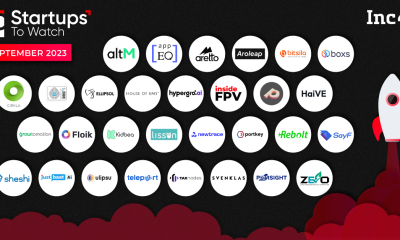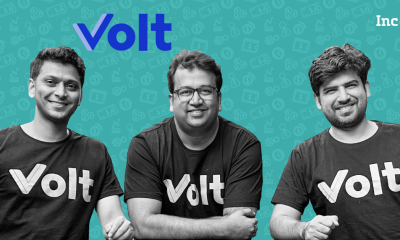Last week, General Motors summoned a small group of journalists to a Beverly Hills mansion to witness the future of home energy. And it started with a preemptive blackout.
Science
At a Beverly Hills mansion, where an electric truck is your only source of power

As sunset fell across the Hollywood Hills, the chief engineer from General Motors flipped a breaker and disconnected the five-bedroom home from the grid. The lights went out, and less than 20 seconds later, GM’s home system powered it back up, pulling just 5kW or less from the fully charged Chevy Silverado EV parked in the garage.
When the lights came back on, the small crowd of journalists and GM Energy employees clapped, as if they were experiencing electricity for the first time.
When the lights came back on, the small crowd clapped, as if experiencing electricity for the first time
While a pickup truck may be an unusual site in the tony neighborhood, the company wanted to show off how its new energy subsidiary, GM Energy, can power an entire home using nothing but the Silverado as a mobile generator. GM wanted to demonstrate the new features of its vehicle-to-home (V2H) energy products at a splashy if mostly sterile mansion in the excessively wealthy Los Angeles enclave.
(In case you’re house hunting, the uber-lux Beverly Hills mansion that hosted GM’s demo is currently for sale for nearly $25 million — and is also rumored to have once belonged to Rat Pack member Dean Martin.)
Before the event, GM Energy installed a bidirectional charger, which the company calls the GM Energy PowerShift Charger, as well as its own V2H Enablement kit, which includes a power inverter, a home hub that includes a computer system that manages the loads through the house, and a backup battery. The full kit retails for $12,699, but buyers can opt for the individual components at the same price.
Using GM Energy’s equipment, the 10,000-square-foot mansion ran exclusively on battery power from the fully charged 215kWh Ultium battery pack underpinning the new Silverado EV for a few hours on a Thursday evening for the event.
But one couldn’t help but be struck by some of the cognitive dissonance on display. Amid cooling demand and flagging sales for EVs, automakers like GM are increasingly trying to market their plug-in cars as something like a Swiss Army knife for the electrical grid. The aim is to entice consumers into spending more on an EV to get access to all these extra features unavailable to anyone driving a car that runs on fossil fuels.
The home ran off the Silverado EV for the rest of the night, powering more than 50 overhead lights inside, music throughout, the kitchen where a full chef’s staff continued to turn out hot hors-d’oeuvres for guests, and exterior lighting that ran all the way down the 200-foot long driveway.
While EV technology opens up a number of new and innovative benefits for the consumer, and there are plenty of benefits to creating V2H systems for EVs, the clean energy market has put up somewhat mixed financial results in recent months. Still, GM remains bullish and barreling ahead with a team hired from private equity, climate tech, and more.
“This is truly unlocking the potential of GM’s electric vehicle lineup”
“This is truly unlocking the potential of GM’s electric vehicle lineup,” said Wade Sheffer, VP of GM Energy. “Having that technology, in that garage, prepared to do what it’s doing right now, raises this property’s valuation even more.”
“If you put one of these GM Home systems in every single customer’s home, you can create a decentralized grid,” added William Hotchkiss, head of safety and supplier quality, purchasing, and supply chain. “You can start to make it a connected network so that you can manage demand, and everyone will have more reliability.”
GM launched GM Energy in 2022 as a way to compete in the growing home energy market and has plans to sell additional equipment, including the Power Bank or stationary home battery system.
The automaker is no stranger to dabbling in areas that seem incongruent with its core automobile business. It made mechanical hearts in the 1950s and, more recently, respirators during the covid-19 pandemic.
Yet, in an era when EV sales have not grown as quickly as many automakers had anticipated, questions remain about whether it makes good business sense to get into home energy. The market isn’t small, but it’s not exactly growing, with current estimates putting its worth at around $150 billion.
Questions remain about whether it makes good business sense to get into home energy
Other automakers have also sensed an opportunity. Tesla touted its energy business, which includes home chargers, stationary batteries, and solar panels, as a bright spot during last month’s earnings call. The company recently announced that it would start rolling out bidirectional charging in 2025. In the home battery and solar installation market, Tesla dominates.
Hyundai offers its own home energy integration, which includes solar panels and battery storage, alongside its EVs like the Ioniq 5 and 6, which have bidirectional charging. But the automaker has said it’s more focused on vehicle-to-grid power over vehicle-to-home.
GM is taking a similar approach and partnering with Qmerit to help homeowners install their GM Energy technology. The company says that its new “holistic” home system will “help accelerate EV adoption.
As Sheffer put it during our interview, “General Motors simply believes we’re going to have mass adoption of EVs, and we’re going to invest in the whole ecosystem. We’re a separate company within the company, so General Motors invested in us to deliver all of the pieces of that possible.”
While the Silverado EV is the only current vehicle that has this V2H ability, eventually GM’s other electric vehicles, including the GMC Sierra EV Denali, Chevy Equinox and Blazer EVs, and Cadillac Lyriq, will get it, too, either via an over-the-air or dealer-installed update.
While these features are similar to those already offered on the Ford F-150 Lightning, GM is promising to make it more accessible to the masses. Its plan is to transform its complete lineup of EVs to enable V2H capabilities. But at launch, there are no plans to open the system up to third parties.
For example, the GM Home kit is currently not compatible with other EVs, including the Honda Prologue, which also gets GM’s Ultium battery. According to executives at last week’s event, there are no current plans to change that until ISO standards change.
“Right now, GM Energy offers the most comprehensive home charge ecosystem on the market, bar none,” Sheffer said. “Once we had the power bank and connection to solar, stop the tires.”
“Once we had the power bank and connection to solar, stop the tires”
Hotchkiss and Sheffer also confirmed that there are no current plans for GM to get into the solar panel manufacturing or installing business right now, given how fraught the space can be. (The company previously said it would work with third-party solar providers, like Sun Power.) Plans to allow customers to sell excess energy back to the grid are still in the works, according to Sheffer, noting that GM is currently piloting some smaller programs with utilities across the nation.
These backup power systems essentially provide microgrids for communities and homeowners looking to insulate themselves from blackouts due to extreme weather resulting from climate change.
As the world heats up and climate change stretches the electrical grid closer to its limits, consumers are increasingly looking for ways to ensure they still have access to reliable power. Since EVs spend the majority of their time parked in home garages and plugged in, GM sees an opportunity to leverage those parked EVs for power storage. The demonstration last week shows what that might look like.
Politics are also at play in the energy space. As demand for electricity grows, coal plants close, and more solar and wind power come online, some politicians and critics of clean power see the potential for a power reliability crisis to increase. By providing a way for people to power their homes when the grid goes down, GM says it is opening new opportunities for individual consumers. And with Tesla’s polarizing CEO Elon Musk increasingly alienating some of his most loyal potential customers, GM offers a less “political” alternative.
It also turns out that consumers want these kinds of features from their EVs, at least according to a recent study by JD Power. The study found that over a third of EV owners said they were interested in bidirectional charging as a way to make money by selling power back to the grid and to help balance peak electrical demands.
While it’s still very early days for GM Energy and its suite of new features supporting V2H support, executives are positive about the future of the venture. “GM is an automobile company, pulling from the grid. It only makes sense that we have the whole ecosystem,” Sheffer said. “That’s why GM said we’re going to pioneer this. If we don’t start, nobody is ever going to get there. So here we go.”
This was no temporary solution, either. GM executives promised that the mansion could run for three to four days at that level of consumption before fully depleting the battery. When I left at around 9:30PM, the charge on the Silverado EV had only dropped by 1 percent.
Science
Jeff Bezos’ Blue Origin plans to launch a new crew capsule on Monday

Blue Origin is preparing to launch its NS-27 mission with the RSS Kármán Line, its new crew capsule, on Monday at 9AM ET. It will be the first launch for the capsule, which the company says in its announcement will have improved performance and reusability, along with “an updated livery, and accommodations for payloads on the booster.”
The flight will carry two LIDAR sensors into space that will be used for Blue Origin’s Lunar Permanence program to develop Moon landers. Those are among 12 payloads that also include ultra-wideband proximity operations sensors, a reproduction of the black monoliths from 2001: A Space Odyssey, and student postcards submitted to its Club for the Future nonprofit. Blue Origin will stream the launch on its website, starting 15 minutes before liftoff.
NS-27’s next flight comes as Blue Origin works toward the goal of becoming a real SpaceX competitor. Company CEO Dave Limp, the former Amazon hardware boss who took over late last year, said the company needs to “be able to build things a lot” to become “a world class manufacturer” in an interview with CNBC.
“We’d like to [be delivering] about an engine a week by the end of the year. I’m not sure we’ll get exactly to a week, but it’ll be sub-10 days … [and] by the end of 2025, we have to be faster than that,” Limp said.
Blue Origin plans to launch New Glenn, its big reusable booster that recently completed its first second-stage hot fire test, for the first time in November. Blue Origin says the rocket can deliver 45,000 kilograms (more than 99,000 pounds) into low Earth orbit, which CNBC notes is roughly double what SpaceX’s Falcon 9 can do. The company also hopes to land the booster on its first flight.
Science
Big Tech has cozied up to nuclear energy

Tech giants are increasingly eyeing nuclear reactors to power their energy-hungry data centers. Amazon and Microsoft each inked major deals this year with nuclear power plants in the US. And both Microsoft and Google have shown interest in next-generation small modular reactors that are still in development.
New AI data centers need a lot of electricity, which has taken companies further away from their climate goals as their carbon emissions grow. Nuclear reactors could potentially solve both of those problems. As a result, Big Tech is breathing new life into America’s aging fleet of nuclear reactors while also throwing its weight behind emerging nuclear technologies that have yet to prove themselves.
“Certainly, the prospects for this industry are brighter today than they were five and 10 years ago,” says Mark Morey, senior adviser for electricity analysis at the US Department of Energy’s Energy Information Administration.
“Certainly, the prospects for this industry are brighter today”
Much of America’s aging nuclear fleet came online in the 1970s and 1980s. But the industry has faced pushback following high-profile accidents like Three Mile Island and the Fukushima disaster in Japan. Nuclear power plants are also expensive to build and generally less flexible than gas plants that now make up the biggest chunk of the US electricity mix. Gas-fired power plants can more quickly ramp up and down with the ebb and flow of electricity demand.
Nuclear power plants typically provide steady “baseload” power. And that makes it an attractive power source for data centers. Unlike manufacturing or other industries that operate during daytime business hours, data centers run around the clock.
“When people are sleeping and offices are shut and we’re not using as much [electricity], what matches nuclear energy very nicely with data centers is that they pretty much need power 24/7,” Morey says.
That consistency also sets nuclear apart from wind and solar power that wane with the weather or time of day. Over the past five years or so, many tech companies have accelerated climate goals, pledging to reach net zero carbon dioxide emissions.
The added energy demand from new AI tools, however, has put those goals further out of reach in some cases. Microsoft, Google, and Amazon have all seen their greenhouse gas emissions climb in recent years. Getting electricity from nuclear reactors is one way companies can try to bring those carbon emissions down.
A feat that’s never been done before in the US
Microsoft signed an agreement to purchase power from shuttered Three Mile Island in September. “This agreement is a major milestone in Microsoft’s efforts to help decarbonize the grid in support of our commitment to become carbon negative,” Microsoft VP of energy Bobby Hollis said in a press release at the time.
The plan is to revive the plant by 2028, a feat that’s never been done before in the US. The plant “was prematurely shuttered due to poor economics” in 2019, according to Joe Dominguez, president and CEO of the company, Constellation, that owns the plant. But the outlook for nuclear energy now is rosier than it has been for years as companies look for carbon pollution-free sources of electricity.
In March, Amazon Web Services purchased a data center campus powered by the adjacent Susquehanna Nuclear power plant in Pennsylvania. That $650 million deal secures electricity from the sixth largest nuclear facility in the US (out of 54 sites today).
Google is considering procuring nuclear energy for its data centers as part of its sustainability plans. “Obviously, the trajectory of AI investments has added to the scale of the task needed,” CEO Sundar Pichai said in an interview with Nikkei this week. “We are now looking at additional investments, be it solar, and evaluating technologies like small modular nuclear reactors, etc.”
He’s referring to next-generation reactors that are still in development and not expected to be ready to connect to the power grid until the 2030s at the earliest. The US Nuclear Regulatory Commission certified a design for an advanced small modular reactor for the first time last year. These advanced reactors are roughly one-tenth to one-quarter the size of their older predecessors; their size and modular design are supposed to make them easier and cheaper to build. They might also be more flexible than larger nuclear plants when it comes to adjusting how much electricity they produce to match changes in demand.
Bill Gates, for one, is all in on nuclear energy. He’s the founder and chair of TerraPower, a company developing small modular reactors. Last year, Microsoft put out a job listing for a principal program manager to lead the company’s nuclear energy strategy that would include small modular reactors.
Bill Gates, for one, is all in on nuclear energy
“I’m a big believer that nuclear energy can help us solve the climate problem, which is very, very important,” Gates said in an interview with The Verge last month.
This week, the Department of Energy released a new report projecting that US nuclear capacity could triple by 2050. After flatlining for years, electricity demand is expected to rise in the US thanks to EVs, new data centers, crypto mining, and manufacturing facilities. That growing demand is changing the outlook for nuclear energy, according to the report. Just a couple years ago, utilities were shutting down nuclear reactors. Now, they’re extending reactors’ lifetimes by up to 80 years and planning to restart ones that have shuttered, it says.
“It is reasonable to think that the tech companies could catalyze a new wave of investment in nuclear, in the US and around the world. There has been plenty of talk about the idea in the industry,” Ed Crooks, Wood Mackenzie senior vice president, thought leadership executive for the Americas wrote in a blog post this week.
This doesn’t necessarily mean that it’s all smooth sailing ahead for nuclear energy in the US. New reactor designs and plans to reopen shuttered nuclear power plants are still subject to regulatory approval. Initiatives to build both old-school power plants and new designs have faced soaring costs and delays. Amazon already faces opposition to its nuclear energy plans in Pennsylvania over concerns that it could wind up driving up electricity costs for other consumers. And the nuclear energy industry still faces pushback over the impact of uranium mining on nearby communities and concerns about where to store radioactive waste.
“It’s an interesting time, challenging in many ways,” Morey says. “We’ll see what happens.”
Science
Watch what it’s like to handle an overturned truck full of burning batteries

A truck full of lithium-ion batteries was knocked over near the Port of Los Angeles on September 26th, exploded, and was left to burn for days — interrupting traffic on highways, and a bridge and shutting down port terminals. A local towing company, Pepe’s Towing Service, caught the explosion on camera and vlogged the incident for days until it was time for them to haul the remnants away.
Pepe’s Tow Service owner Josh Acosta uploaded a lengthy video today chronicling the point of explosion, the long wait as the Fire Department let the batteries burn, and the process of lifting the container full of burnt batteries to transport. In the video, we see what looks like stacks of batteries with liquid cooling pipes between each layer.
Image: Pepe’s Towing Service
Image: Pepe’s Towing Service
Image: Pepe’s Towing Service
In a phone call with The Verge, Acosta says the battery is one “giant container-sized battery” that “does not come apart.” He believes it could be used in buildings for backup power. According to Acosta, the battery weighed 60,000 pounds.
Acosta says he doesn’t remember which company owns the container that transported the battery — but his video blurs out text on the side of the container anyhow.
The video shows the painstaking logistics for firefighters dealing with burning lithium-ion cells — they often need to use thousands of gallons of water to put these out, including on electric vehicle fires. And in this case, the Los Angeles Fire Department told The Verge that the fire kept going on and off.
Acosta told us he was called to the job by the customer who owns the overturned truck, and that’s why he caught the moment on camera. Now, Pepe’s Towing is hauling the remnants of the container for scrap recycling.
-

 Startup Stories12 months ago
Startup Stories12 months agoWhy Millennials, GenZs Are Riding The Investment Tech Wave In India
-

 Startup Stories12 months ago
Startup Stories12 months agoStartups That Caught Our Eyes In September 2023
-

 Startup Stories1 year ago
Startup Stories1 year agoHow Raaho Is Using Tech To Transform India’s Fragmented Commercial Trucking
-

 Startup Stories11 months ago
Startup Stories11 months agoMeet The 10 Indian Startup Gems In The Indian Jewellery Industry’s Crown
-

 Crptocurrency7 months ago
Crptocurrency7 months agoLither is Making Crypto Safe, Fun, and Profitable for Everyone!
-

 Startup Stories12 months ago
Startup Stories12 months agoHow Volt Money Is Unlocking The Value Of Mutual Funds With Secured Lending
-

 E-commerce12 months ago
E-commerce12 months agoTop Online Couponing Trends To Watch Out For In 2016
-

 Startup Stories12 months ago
Startup Stories12 months agoWhy Moscow-Based Kladana Considers Indian SME Sector As The Next Big Market For Cloud Computing




